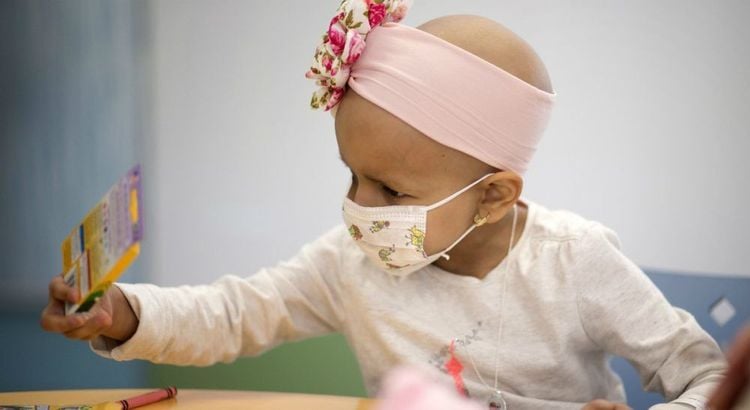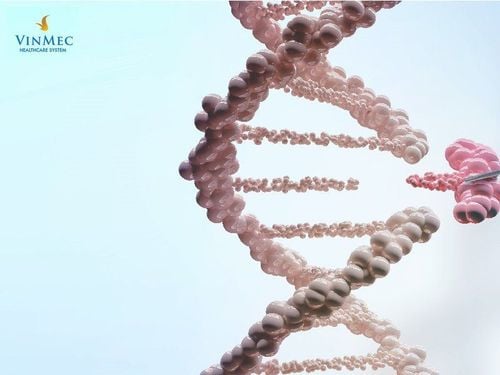This is an automatically translated article.
Posted by Dr. Pham Thi Viet Huong - Doctor of Hematology - Oncology - Hematology and Cell Therapy Unit - Center for Regenerative Medicine and Cell Therapy, Vinmec International General Hospital Times CityCancer inherently does not spare anyone, even children. It is estimated that every year in the world, a very large proportion of people die from cancer. Therefore, it is very important to recognize and learn the signs of cancer in children to give them a better chance of treating the disease and ensuring their health in the future.
1. Childhood Cancer
Accurate estimates of childhood cancer incidence are important for policymakers to make prioritization and planning decisions. However, many countries do not have cancer registries that quantify the incidence of childhood cancer. Furthermore, even with a registry system in place, they may underestimate the true incidence, as children with cancer may go undiagnosed.Therefore, the aim of our study was to provide estimates of the overall low incidence of childhood cancers.
We have deployed micro-models to simulate childhood cancer rates in 200 countries and territories worldwide, taking into account urban and population growth trends, changes in geography of cancer incidence and health system barriers to diagnosis and undiagnosed. To ensure model results were consistent with epidemiological data, we calibrated the model to public cancer registry data using a Bayesian approach where observational data were fixed and the Model parameters (cancer incidence, probability of accessing and referring to the health system) are random variables. We estimated the total incidence of childhood cancers (diagnosed and undiagnosed) in each country in 2015 and predicted the number of cases from 2015 to 2030.

Our model estimates that there were 397,000 (95% uncertainty [UI] 377,000 – 426,000) cases of childhood cancer worldwide in 2015, of which there were only 224,000 (95 % UI 216,000 - 237,000) diagnosed. This finding revealed that 43% (172,000 out of 397,000) of childhood cancer cases were undiagnosed globally, with significant regional variation, from 3% in Western Europe (120 out of 4300). and North America (300 out of 10,900) to 57 percent (43,000 out of 76,000) in western Africa. In South Asia (including Southeast Asia and South Central Asia), the overall rate of undiagnosed cases is estimated to be 49% (67,000 out of 137,000). Taking into account population projections, we estimate there will be 6.7 million (95% UI 6.3 - 7.2) childhood cancer cases worldwide between 2015 and 2030. Given the efficiency of the current health system, we estimate that 2.9 million (95% UI 2.7 - 3.3) childhood cancer cases will be underdiagnosed between 2015 and 2030.
Childhood cancer is actually underdiagnosed, especially in South Asia and sub-Saharan Africa (including western, eastern and southern Africa). In addition to improving childhood cancer treatment, health systems must be strengthened for accurate diagnosis and effective care for all children with cancer. As countries expand universal health coverage, these total rate estimates are expected to help guide efforts to appropriately strengthen health systems to ensure access to care. effective cancer care in children.
In Vietnam, the pediatric oncology major faces many difficulties. Well-trained pediatric oncology doctors and nurses seem to only count on their fingers because medical universities do not have a pediatric oncology department (only oncology department with lectures on oncology). adult letters and a few elementary lectures on pediatric cancer, pediatrics). In the training model in advanced countries, it is mandatory to become a pediatric oncologist before being a pediatric specialist. Childhood cancer is very different from adult cancer. We only have a few centralized pediatric cancer treatment facilities. Most provincial and district hospitals do not have pediatric oncologists. Propaganda about childhood cancer is still very weak, so most children are diagnosed at a late stage or go undiagnosed.

Cancer is the leading cause of disease-related deaths among American children, resulting in the deaths of approximately 1,800 children each year. About 1,190 children under the age of 15 are expected to die of cancer in 2020. According to the National Survival Statistics Report, volume 68, 2019, the US Centers for Disease Control, a study of 3774 children 1-19 age of death, cancer deaths account for 51%, followed by heart disease 18%, influenza and pneumonia 8%...
In some low- and middle-income countries, only 20% of children will live omission. More than 40,000 children undergo cancer treatment each year.
In Vietnam, there are no complete statistics on the whole country. According to the World Health Organization, childhood cancer in general cannot be prevented or screened for.
Improving outcomes for children with cancer requires early and accurate diagnosis, followed by effective treatment. Most childhood cancers can be cured with generic drugs and other forms of treatment including surgery and radiation. Childhood cancer treatment can be cost-effective across all income levels.
Avoidable deaths from childhood cancer in low-income countries include underdiagnosis, misdiagnosis or delayed diagnosis, barriers to care, treatment abandonment, toxic death and higher recurrence rates...
There is a need for systematic pediatric cancer data to drive continuous improvement in quality of care and drive policy decisions.
An accurate diagnosis is essential to treating children with cancer because each cancer requires a specific treatment regimen that may include surgery, radiation, and chemotherapy. Access to effective diagnosis, essential drugs, pathology, blood products, radiation therapy, psychosocial and supportive care is different and unequal around the world.
Common childhood cancers include: brain tumors, acute leukemia, lymphomas (non-Hodgkin and Hodgkin), neuroblastoma, nephroblastoma, soft tissue sarcomas, bone, retinoblastoma desert...
Trắc nghiệm: Thử hiểu biết của bạn về bệnh ung thư
Ung thư là nguyên nhân gây tử vong hàng thứ 2 trên thế giới. Thử sức cùng bài trắc nghiệm sau đây sẽ giúp bạn có thêm kiến thức về yếu tố nguy cơ cũng như cách phòng ngừa bệnh ung thư.
Bài dịch từ: webmd.com
2. Symptoms of cancer in children
The symptoms suggestive of cancer in children are as follows, parents should pay attention and promptly send their children to the hospital for diagnosis and treatment:2.1. Prolonged fever of unknown cause
Children with signs of persistent fever of unknown cause. Besides, children also sweat a lot, especially at night.
2.2. There are bruises on the skin or nosebleeds
If the young person suddenly appears bruised, or red rash for no reason, or the child has frequent nosebleeds, this is most likely a sign of blood cancer in children. This phenomenon occurs due to poor clotting ability due to high white blood cell count, compression of platelets and red blood cells.2.3. Children with anemia have pale skin
Blood cancer causes white blood cells to increase and red blood cells to decline, but red blood cells have the function of carrying oxygen throughout the body, when red blood cells are lacking, children will experience dizziness, dizziness, pale skin, and shortness of breath. steep,... Even children may have language disorders, speak poorly...2.4. Unexplained rapid weight loss
When suffering from blood cancer, the blood cancer cells make the child's abdomen uncomfortable, cause a loss of appetite, make the child lose weight, and the body is weak.2.5. Children having difficulty breathing
The reason why children with leukemia have trouble breathing is because white blood cells that thrive can gather around the thymus, near the neck, making it difficult for children to breathe.2.6. Children often get infections
Frequent, persistent infection is one of the manifestations of blood cancer. Manifestations of infection caused by blood cancer are: cough, fever, runny nose ... and this situation will not be relieved even with antibiotics.2.7. Abdominal pain, bloating
Because white blood cells thrive and accumulate in internal organs such as the liver, kidneys, spleen, etc., children have abdominal pain and bloating.2.8. Swollen lymph nodes
When a child has leukemia, the lymph nodes in the neck area, under the arms, and in the groin will become enlarged and stiff due to the accumulation of many white blood cells.
2.9. Joint pain
Blood is normally produced in the bone marrow, but with blood cancer, the amount of red blood cells is reduced due to high white blood cells, the excessive accumulation of white blood cells will compress, impact on bone tissue causing pain.2.10. Pupil white spot, "cat's-eye" sign
Parents may see children's eyes flashing when taking flash pictures, in the dark, seeing pupils with white spots, or cross-eyes, background swelling, red eyes.If cancer is detected at an early stage, the child has a better chance of being saved. The treatment is a combination of chemotherapy and surgical treatments. . . depending on the type of disease and the age of the child.
Cancer inherently does not spare anyone, it is estimated that every year in the world, a very large proportion of people die from cancer. In fact, if cancer can be detected at an early stage, the prognosis for treatment is very high, even if it is completely cured and not recurred. Therefore, cancer screening is essential, especially for high-risk patients.
With many years of experience in examining, treating and screening for diseases in children, now the Pediatrics Department at Vinmec International General Hospital has become one of the major health care centers, capable of ability to examine, screen and treat many specialized diseases in children. In addition, to improve the quality of services, Vinmec now has packages of General Health Check-ups for children under 18 years old and packages of early cancer screening. Therefore, when a child has abnormal signs, parents can take the child to Vinmec International General Hospital for a health examination and screening for pathology.
Please dial HOTLINE for more information or register for an appointment HERE. Download MyVinmec app to make appointments faster and to manage your bookings easily.
References:US National Center for Biotechnology Information US National Cancer Institute US National Institutes of Health US National Institutes of Health Zachary J Ward, Jennifer M Yeh, Nickhill Bhakta et al (2019) ), Estimating the tot al incidence the total incidence of global childhood cancer: a simulation-based analysis, The Lancet Oncology 2019, VOLUME 20, ISSUE 4, P483-493, APRIL 01, 2019)













